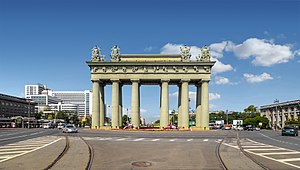Moscow Triumphal Gate

The Moscow Triumphal Gate (
19th century
At the beginning, the triumphal gate was supposed to be erected by the
The Moscow Triumphal Gate were designed by the Russian architect
The chief material to be used in building the gate was cast iron. The castings for the ends of the columns and walls located above the cornices, the forging from the sheets of copper sculpture details including the figures of geniuses, trophies and upper parts of the columns were produced at a local factory. The cast iron for the columns were cast in another local factory.[2]

Each column is composed of nine separate blocks together with the trunks and the upper units of the columns. All 12 columns weigh approximately a combined 450 tons. The first column was erected on July 14, 1836. The gate were finally opened two years later, on October 16, 1838. At that time, the Moscow Gate were the largest structure in the world made of cast iron.[3]
The monumental portico made of the powerful columns symbolized greatness and glory of the Russian army. The war victory theme was further underlined with the sculpture compositions of war trophies, signs and weapons. The use of a frieze of 30 sculptural figures of genius made from copper sheets of seven different models in the monument was considered an architectural innovation of the day.
Being erected as a memorial of a military victory, the main concept behind the gate was the ostentatious display of state power. This concept is inherent in most of Stasov's designs in Saint Petersburg, such as the
20th century
In 1936, during the period of
References
- Раскин А. Г. Триумфальные арки Ленинграда. Leningrad, 1977.
 Media related to Moscow Triumphal Gate at Wikimedia Commons
Media related to Moscow Triumphal Gate at Wikimedia Commons
